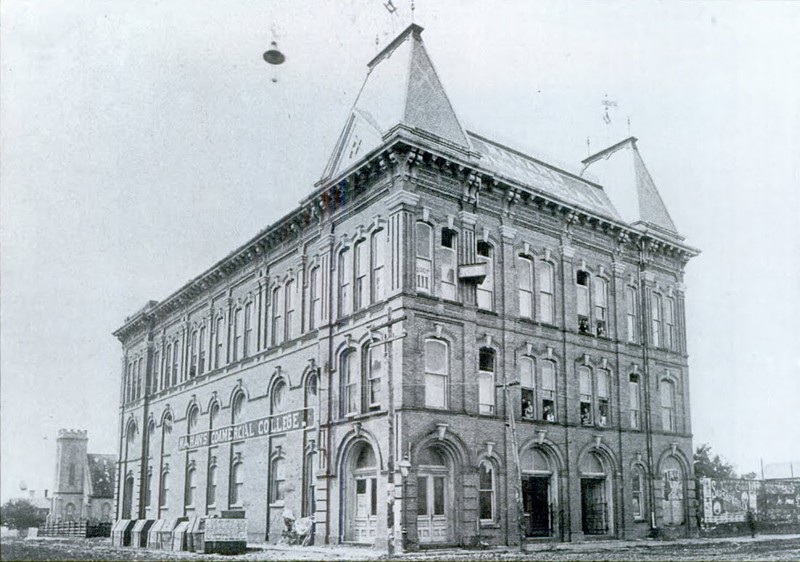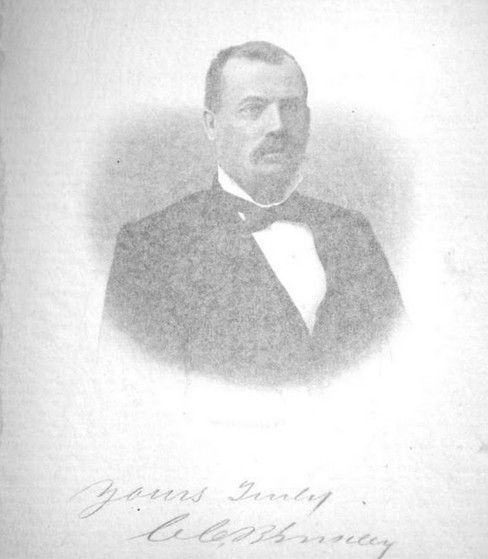Site of the Old Sherman Masonic Temple and Opera House
Introduction
Text-to-speech Audio
Images
Sherman Masonic Temple and Opera House open from 1881 to 1918

Judge C. C. Binkley. Born in Tennessee in 1827. Moved to Grayson County in 1853.

Backstory and Context
Text-to-speech Audio
For Sherman, the construction of the Masonic Temple and Opera House was a part of a broader trend bringing “new banks, colleges, [and] hotels” to the area.3 Reconstruction and the rise of the railroad helped to bring economic opportunity to Sherman, as well as institutions like Austin College, giving the city the nickname “The Athens of Texas.”3 The construction of the Sherman Opera House helped to make Sherman not just an economic center, but a “cultural center” as well.2
Outside of the Sherman Chapter of the Freemasons, three names are generally associated with the creation of the Sherman Opera House. George Dickey was the architect behind the Opera House. Dickey, despite being born in New Hampshire and training in Boston, designed “numerous public, commercial, and residential buildings in Houston” in the late 19th century, including the Capitol Hotel, “built on the site of the provisional capital of the Republic of Texas.”6 Judge C. C. Binkley, who organized and helped to fund the endeavor; L. F. Ely, a former captain in the Confederate army and a member of the Sherman Masons, provided materials for construction, just as he also did for the construction of the Sherman Courthouse in 1876. Judge Christopher Columbus Binkley, meanwhile, was the primary stockholder of the Binkley Hotel, the president of the Merchants and Planters (M & P) Bank, and the President of the Masonic Temple Co. which constructed the Opera house - as well as serving as a district court judge from 1870 to 1874.
The three organizations that Binkley headed worked as a sort of symbiotic entity; the bank, the hotel, and the opera house served much of the same clientele, and all drew notable visitors to Sherman. The bank quickly became a hub for business which would attract visitors to the hotel. Likewise, the opera house attracted “popular and prominent men and women” to Sherman and to the Binkley Hotel.9 This business model was so successful that when former president Taft visited Sherman, Texas he also stayed in the Binkley Hotel.
When the Opera House was constructed in the 1880s, Sherman was at “a pinnacle in Texas economic history,” boasting “the largest population of any county in Texas” and later named “the financial center of Texas.”3 When business began to fade, however, so too did the fortunes of the Opera House, which closed its doors in 1918.
Sources
1. Hawkins. "The Opera House." The Opera House. Accessed November 26, 2018. http://usgenwebsites.org/TXGrayson/ENTERTAINMENT/OPERA/ShermanOperaHouse/OperaHouse.html.
2. Ashby, Linda. Sherman. Charleston, SC: Arcadia, 2011.
3. "Civil War & Reconstruction." History of Sherman. Accessed November 26, 2018. https://www.ci.sherman.tx.us/314/History-of-Sherman.
4. Binkley, Christopher C. "Notice to Contractors." The Dallas Herald, May 22, 1881. Accessed November 25, 2018.
5. Effie, Carolyn. "[Texas Historical Commission Marker: Old Sherman Opera House]." The Portal to Texas History. November 01, 2012. Accessed November 26, 2018. https://texashistory.unt.edu/ark:/67531/metapth256865/#who.
6. Fox, Stephen. "DICKEY, GEORGE E." The Handbook of Texas Online. June 12, 2010. Accessed November 26, 2018. https://tshaonline.org/handbook/online/articles/fdi30.
7. Reed, Brian. Brian Reed Masters. T. Michael Parrish, Ph.D. Accessed November 25, 2018.
8. Group, Genealogy Trails History. "CITY DIRECTORY OF THE CITY OF SHERMAN, GRAYSON CO, TEXAS FOR 1876 & 1877." Genealogy Trails. Accessed November 26, 2018. http://genealogytrails.com/tex/prairieslakes/grayson/graysoncountyobituaries.html.
9. "Details for Site of Binkley Hotel." Atlas: Texas Historical Commission. 2002. Accessed November 26, 2018. https://atlas.thc.state.tx.us/Details/5181012871.
10. Speer, William S., and John Henry Brown. Selections from the Encyclopedia of the New West, Containing Fully Authentical Information of the Agricultural, Mercantile, Commercial, Manufacturing, Mining and Grazing Industries, and Representing the Character, Development, Resources and Present Condition of Texas, Arkansas, Colorado, New Mexico and Indian Territory: Also, Biographical Sketches of Their Representative Men and Women. Marshall, TX: United States Biographical Pub., 1881.